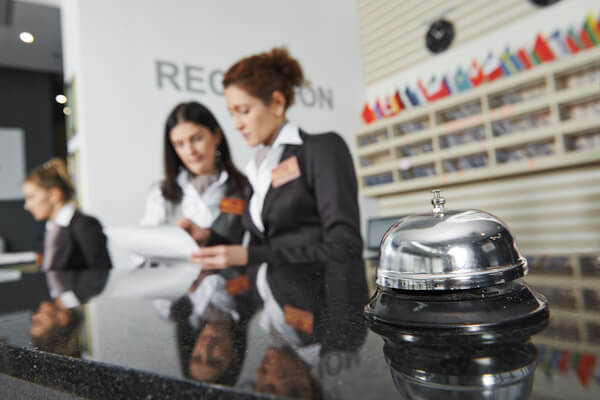5 Seemingly Harmless Details That Affect Your Hotel Email Open Rates
As we’ve talked about previously, your hotel email open rates are key to your marketing and guest surveys success. When done right, the average return on every $1 spent on email marketing is around $44.25, so taking the time to refine your strategy is well worth your while.
Whether you’re thinking about beginning an email marketing initiative or have been doing it for years, here are five details to keep in mind that can make or break your email open rates.
1. The Sender
How many times have you seen a name pop up on your caller ID and cringed? Or worse, you saw a generic 1-800 number and hit ignore immediately? This is the reaction you want to avoid when emailing your contact database.
Most hotel guests can spot a promotional email from miles away, and the sender (both the name and the email address) often play a huge part in this.
What can you do?
Think about your hotel’s branding strategy and test different strategies. You can try the name of your hotel, say, “Avertine Inn” as the name of the sender. Or, try sending emails from the name and address of an important or highly visible staff member, like a favorite front desk clerk, if your staff is small and has individual interactions with each guest. “Ricky at Avertine Inn,” for example. Try to trigger your guests’ memory of their stay with you in whatever you choose. Anything is better than an unfriendly “noreply.”
This is especially important if you’re a hospitality management group. Your guest will have no idea who “ABC Management Company” is, but they’ll recognize the specific name of the hotel where they stayed, “Avertine Inn, Seattle.”
2. The Subject Line
With 64% of people opening an email based on the subject line, this little one-liner holds a lot of weight in the success of your hotel marketing and surveys efforts. Your subject line needs to stand out as a personal, relevant conversation with your guests in order to earn their coveted click.
What can you do?
Avoid “Red Flag” Words. Sale, Free, Deal, Save; These words are drastically overused, and most savvy consumers see them and know the sender is just after their wallets. Additionally, using these words can often result in your email being caught in spam filters.
These emails come off as cold and impersonal, and this is not something you want to communicate when you’re looking to build a loyal customer base.
Be Brief. On average, subject lines with six to 10 words generate a 21% open rate, while those with 11-15 tend to only generate an open rate of 14%.
To keep your readers’ interest, you need to be able to say a mouthful in just a few bites. Shorter subject lines are also better optimized for mobile browsing, so don’t be afraid to keep it short and sweet.
Create Intrigue. Treat your hotel email subject line like an article headline. It has to be direct enough to let your guests see the value in clicking through, but intriguing enough to force them to do so. You can try hinting at an incentive, or even asking a question.
Personalize It. Personalizing your subject line by including your guest’s name creates the impression that you are speaking directly to them. It creates the impression that this email was written with their individual needs in mind. Personalized emails also have a 25% higher open rate and 51% higher click rate.
3. The Preview Text
Like your subject line, your preview or “snippet text” is one of your only opportunities to convey value and show the recipient why they need to open your email.
What can you do?
Some email platforms allow you to choose the text you’d like to appear here. But, many platforms auto-generate this based on the alt-text of your header image.
When you can customize your preview text, keep it simple and to the point. Expand on your subject line and show the reader in deeper detail the value of opening the email. For example:
In both examples, the subject line introduces the topic of the email, and the preview text ads some personalization elements and a bit more detail about the value inside.
4. Your Delivery Time
Like with all hotel marketing, timing and context is key. You want to reach the right guest at the right time with the right message or offer in order to elicit the right action.
For example, KISSMetrics found that emails relating to work or financial services tend to perform best directly after lunch when employees are “in the zone,” while holiday promotions or those regarding vacations tend to do best after hours when employees are working late.
What can you do?
The habits of your guests will vary. You’ll want to a lot of testing with your audience to determine the best time to send a promotional email. Test, analyze, then test again. While marketing industry resources like KISSMetrics can be helpful, nothing is more valuable than data from your own guests.
If you’re just starting out, you can work with general buyer behavior data like KISSMetrics’. But, it’s an absolute MUST that from that point on, you analyze your own data and do your own A/B testing. Use your guests’ responses to your own emails to benchmark your next campaign.
5. Personalize in Small Batches
No two guests are ever alike. While emailing your entire guest database might seem like a fast, efficient way to get the word out, broad, un-targeted emails like these are destined to garner high un-subscribe rates, low open rates, or worse, spam reports.
Bulk emails lack the specifics needed to truly connect with your guests and engage with them to nurture the close one-to-one relationship that will ultimately build loyalty with your property or brand.
What can you do?
Segment your guest database, based on commonalities in personal characteristics and what your hotel has to offer. This will ensure that you are reaching the right guests with messages and offers that are relevant to their interests and circumstances. Consider segmenting by things like:
Geographic Location: Is location critical to the subject matter of your message? For example, if you notice that your occupancy is low for this upcoming weekend, you could send out a last-minute special rate targeted to individuals who live within a two or three hour drive of your property. You are much more likely to get last-minute bookings from guests who don’t have to book a flight.
Past Purchase Behavior: A guest who has previously booked a massage will be disappointed if he or she arrives at your hotel to find that the spa is totally booked. If your incoming guests were segmented based on past stay information and you noticed that your spa appointments were filling up, you could target all incoming guests who have previously booked with the spa with a heads up: “Our appointments are filling up. Book now to make sure you don’t miss out!”
Getting Started
If I leave you with any advice about email marketing, it’s don’t rush. A successful promotional email is well thought-out in every way. You’ll want to sit down and brainstorm your strategy in advance to get the best results.
Want to drive more direct revenue and connect with guests? Download our free Email Marketing Strategy Guide. Never before has there been a more jam-packed, industry-specific guide to help hoteliers master the art (and science) of email marketing. Over 40+ topics with actionable insights, strategies, and best practices for email marketing.
Related Posts

Insights that drive results
Subscribe now to get the latest content
This site is protected by reCAPTCHA and the Google Privacy Policy and Terms of Service apply. *Required fields.




